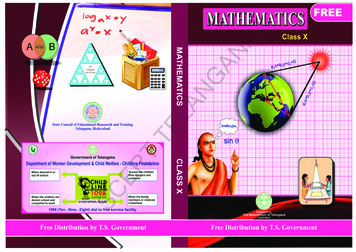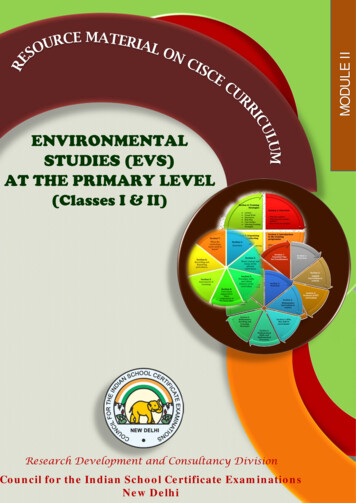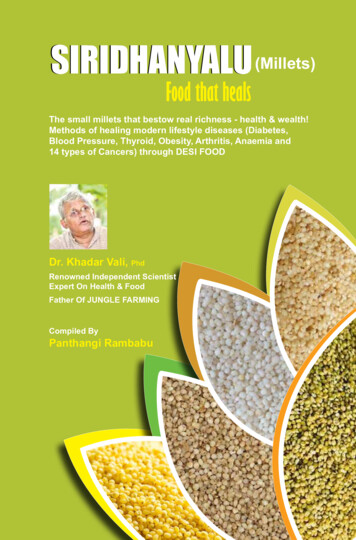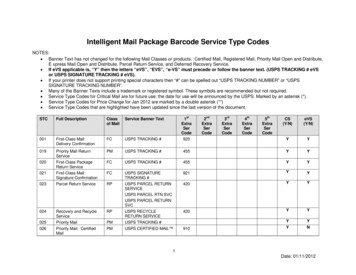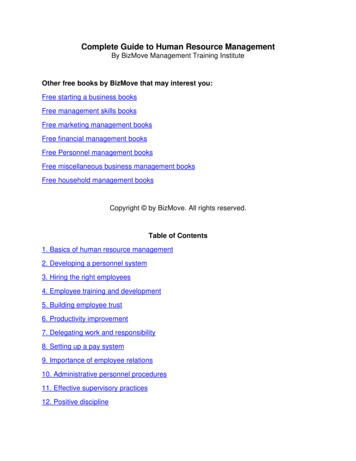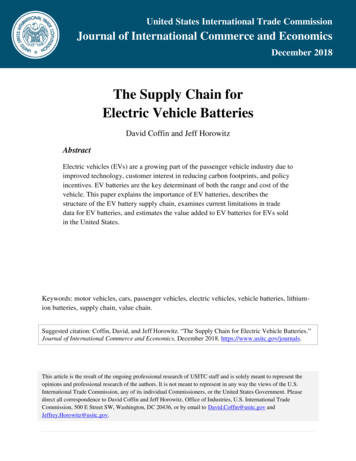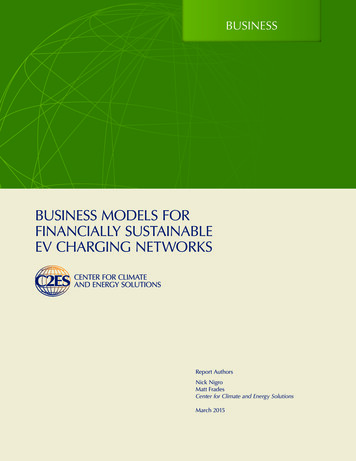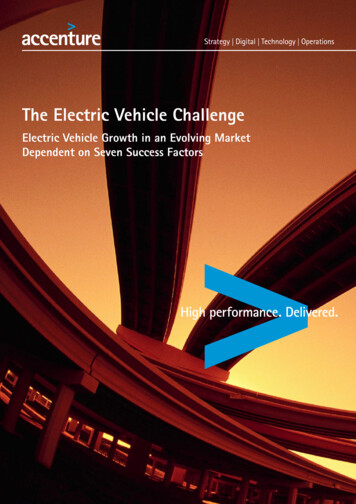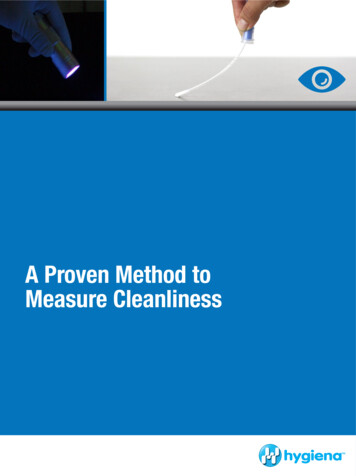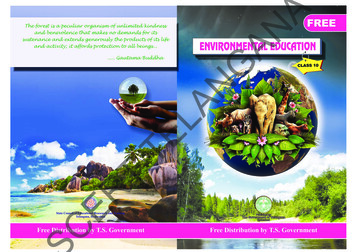
Transcription
TERCLANGTEANA
TEANALANGI feel teaching science is not merely teaching aboutatomic structure , preparation of oxygen andmagnetic lines of force but also to teaching to thinkscientifically, beyond superstitions and to searchfor the solutions of problems. If a child learns aboutwater resources, it must know the technology andprinciples, theories involved in digging a well, a borewell construction of a dam along with the humanresources expended and the value of the sweatspilled during those constructions. Only then itdevelops the attitude of not wasting a drop ofwater. Children should realise that the food in hisplate is the result of hard work and efforts ofmany. They should respect these efforts andunderstand the dignity of labour. When science istaught in this way in our class rooms, it becomesthe most wonderful tool to provide social justice.CERT- Giju Bhai Bhageka.
ENVIRONMENTAL EDUCATIONCLASS - 10Text Book Development CommitteeANASri G. Gopal Reddy, Director,Sri B. Sudhakar, Director,S.C.E.R.T., Hyderabad.Govt. Textbook Press, Hyderabad.Dr. Nannuru Upendar Reddy,Professor & Head C&T Dept.,S.C.E.R.T., Hyderabad.EditorsLANGDr. W.G. Prasanna Kumar, Director, Green corps., Hyderabad.Dr. Nannuru Upendar Reddy, Professor & Head C&T Dept., S.C.E.R.T., HyderabadSri. S. Vinayak, Co-ordinator, C&T Dept., S.C.E.R.T., Hyderabad.Co-ordinatorTEDr. T.V.S. Ramesh, Co-ordinator, C&T Dept.,S.C.E.R.T, Hyderabad.WritersSCERTDr. T.V.S. Ramesh, Co-ordinator, C&T Dept.,S.C.E.R.T, Hyderabad.Sri V. Raghava Rao, Lecturar, APRJC, Sarvail, Nalgonda (Dt)Smt K. Uma Rani, SA, GHS Ameerpet-1, Jawaharnagar, Hyderabad.Smt A. Vanaja, SA, ZPHS Chandupatla, Nalgonda (Dt)Smt P. Parameshwari, SA, ZPHS Takkallapalli, Nalgonda (Dt)Sri B. Jayaraj, SA, ZPHS, Choutuppal, Nalgonda(Dt)Cover page, Graphics & DesigningSri K. Sudhakara Chary, SGT, UPS Neelikurthy, Maripeda, Warangal.Sri Kishan Thatoju, Graphic Designer, Siddipet, Medak.Published by the Government of Telangana, Hyderabad.Respect the LawGrow by EducationGet the RightsBehave HumblyiFree distribution by T.S. Government 2020-21
All rights reserved.ANFirst Published 2014New Impression 2015, 2016, 2018, 2019, 2020LANGNo part of this publication may be reproduced, storedin a retrieval system, or transmitted, in any form or byany means without the prior permission in writing of thepublisher, nor be otherwise circulated in any form ofbinding or cover other than that in which it is publishedand without a similar condition including this conditionbeing imposed on the subsequent purchaser.SCERTTEThe copy right holder of this book is the Directorof School Education, Hyderabad, Telangana.We have used some photographs which are undercreative common licence. They are acknowledge atthe end of the book.This Book has been printed on 70 G.S.M. Maplitho,Title Page 200 G.S.M. White Art CardFree Distribution by Government of TelanganaPrinted in Indiaat the Telangana Govt. Text Book Press,Mint Compound, Hyderabad,Telangana.iiA Government of Telangana, Hyderabad.
Foreward.AMany rules.! Many more successions.? countless interdependencies.! innumerableaccumulations of life.! Disclosure of multiple varieties as we dive in. Nature is the mostwonderful manifestation of creativity. The most innovative creator has principled it to be amiracle. new terms / words must be coined to describe nature , Charles Darwin spellbound in his book “Origin of Species”. It is true! countless species of plants and innumerablespecies of animals found everywhere adds an enchanting element to the nature. Life isfound in ocean depths, snow peaks, sandy deserts and where not! Perhaps only the earthexhibits such a vast variety of life in the universe.LANGANNature is stable yet dynamic, varied but interdependent. Home of all organisms. Eachorganism has its own habitat, its own food chain. They are knit together but they maintaintheir identity. They follow rules not to intrude others paths. A tree is a common habitat foran ant a snake a worm and a bird. Nature provides shelter in the form of forests, mountainshills and lakes. Organisms live there abided by rules. Wonderful lessons are taught by eachand every creature living in nature, provided we are patient enough and recipient to them.Let’s give this a thinking! A serious thinking in fact?SCERTTEWhat are we a negligible part of millions of species, doing when compared to the otherorganisms? Misusing the boons of nature, wasting natural resources and becoming greedyrobbers of nature. No other organism has this credit of destroying mother nature exceptwe, the human beings. Nothing human. We claim to relish the beauty of greenwoods but wemanage to cut them down in the name of development. We are fond of giving lecturers atevery possible opportunity about water being the life giver life saver etc., but we neverbother to stop a leaking tap. What an irony! We plunder minerals, we multiply factoriespolluting the environment in all the ways we can. We face the result in the form ofcontaminated air and infected food. We are inviting the disaster by piercing the Ozonelayer that safeguards the earth. Just think! what are we aiming at?Do we want earth to be turned into ashes? or is it that we want the next generations toinherit hunger, thirst and screams of helplessness?No! Absolutely not! It is high time to know our mistakes! Let’s realise them! Let’s begrateful to the environment! Let’s be wise in sustaining the development! What is the fun ifthe development, costs us our life! We can no more do that! We shall save the beautiful andfertile mother earth not for the sake of earth but for us to live on it.‘Environmental Education’ the book in your hand lets you know about the do’s anddon’ts hence forth. Values cannot be taught, they have to be caught. Caught while acting.Therefore many activities are imparted in this book. Do them with the help or your teacher.Share your Ideas thoughts with all. Hope you’ll inculcate eco friendly behaviour.DirectorState Council of Educational Research and TrainingHyderabad.iiiFree distribution by T.S. Government 2020-21
What we do, whom to doTo reach the goals of environmental education which was implemented as a school subject in ourschool, teachers and students should implement, it with personal responsibility, ownness and by addingsome other concepts and strategies.For teachers To act as a responsible citizen towards environment concepts discussed in the syllabus are alltreated as environmental education. Topics are identified based on different themes – food, health, agriculture, industries, naturalresources, natural world. Before starting every chapter teacher would discuss about the topic with students. So there is aneed for teacher to collect some other source material. Activity performance is totally based onthese discussions only. Collection of data, interview, field trips, projects etc. Strategies are useful to conduct activities. The topics in environmental education is not like other subject areas, so don’t relate this withexams, slip tests, marks etc. Presentation may be in a free and joyful environment. You shouldaward marks or grades to the students, based on your observation. Based on resources, local conditions teacher have freedom to select topics in the book. There isno compulsion to follow only the order mentiond in text book.LANGANA For students Relate these items to your local environment and conduct activities.Participate in pre and post discussion of every activity and express your feelings and possiblesolutions.SCERT TEMake your students to talk about their observations and presentations. Teacher should add somemore questions along with text book, for value discussions. Perform activities in groups. Collect whatever information necessary and prepare required reportson them. Conduct school level seminars, symposiums, prepare slogans related to environmental awarenessevery day in school assembly and display it on bulletin board. Collect different news items on environmental awareness from news papers, magazines and displaythem on wall magazine. Ask your head master to pay subscriptions for Down to Earth, My school, Readers digestChekumuki, Prerana and other science magazines. Prepare your own activities and implement at your school or village.Conduct environmental awareness programmes at factories, fields, slum areas etc.Tomorrow is yours only, you are the future nations wealth. You are the responsible persons thanyour teachers to implement this book. So dear students think scientifically, behave ecofriendly.iv
INDEXS.No.Chapter NamePage No.Global warming12.Saviours of our environment33.Estimation of particulate pollutants in air54.Vaccination - A shield75.Mosquitoes - woes6.Fossil fuels7.Changes in surroundings and their effect8.Use solar energy - Save electricity9.Pollination - an interaction of plants and insects1810.Observing 4 ‘R’s2011.Conserving natural resources2212.Over use of groundwater - it’s consequences2413.Impact of low-cost materials on environment2614.Urbanization - employment opportunities2815.Plenty of water - still we are thirsty!3016.Do we need zoos ?3217.Nature, culture, people and their relationships3418.Household Wastes3619.The plight of ragpickers3820.Water bodies in the neighbourhood4021.Impact assessment of developmental projects4222.Awareness about common ailments4423.Disaster management4624.Education for all - Everybody’s concern4825.Let’s keep our domestic environment healthy5026.Depletion of natural resources5227.Conservation of water resources5428.Flourosis5629.Nature is a sacred place58A1.SCERTTELANGAN9111416vFree distribution by T.S. Government 2020-21
OUR NATIONAL ANTHEMANJana gana mana adhinayaka Jaya heBharatha bhagya vidhata!Punjab Sindh Gujaratha Maratha,Dravida Utkala Banga!A- Rabindranath TagoreLANGVindhya Himachala Jamuna Ganga,Uchchala Jaladhi taranga!Tava shubha name jage!Tava shubha asisha mage!Gahe tava jaya gatha!SCERTTEJana gana mangala dayaka jaya he!Bharatha bhagya vidhatha!Jaya he! jaya he! jaya he!Jaya jaya jaya jaya he!PLEDGE- Pydimarri Venkata Subba Rao“India is my country; all Indians are my brothers and sisters.I love my country, and I am proud of its rich and varied heritage.I shall always strive to be worthy of it.I shall give my parents, teachers and all elders respect,and treat everyone with courtesy. I shall be kind to animals.To my country and my people, I pledge my devotion.In their well-being and prosperity alone lies my happiness.”vi
Item-1Global warmingObjective1. To investigate the impact of greenhouse effect through simulation.BackgroundA2. To search methods to reduce global warming.SCERTTELANGANCarbondioxide, Nitrogen dioxide, Chlorofluoro carbons, Hydro carbons, Methane arecalled Earth heating gasses (Greenhousegasses). Greenhouse gases trap radiation andprevent heat from leaving the earth’s surface.In this process they help to maintain thetemperature of the earth. Excess presence ofthese gases in the atmosphere causes, exessglobal warming.Methodology1. Take two identical glasses of the samematerial. Put equal quantity of water inthem (half filled).2. Note the temperature of water of boththe glasses using a thermometer.3. Place both the glasses out in open spaceso that sunlight directly falls on them.4. Invert a glass bowl or a jar over one glasssuch that it is covered completely.5. Atleast after two hours, note thetemperature of water in both the glasses.6. Note the difference in temperature of thetwo samples. Note which one is hotter.1Free distribution by T.S. Government 2020-21
7. Repeat the experiment with equal amount of ice in the two glasses instead of water.Note the time taken by ice to melt completely.9. Try to find out the reasons for difference in the temperature of water and the time takenfor melting of ice. ‘ConclusionAFactories, chemical industries are primary responsible factors for global warming.Different human activities are also responsible for it.ANThe Chloro Fluoro carbons which are used in air condition are refrigerators, are releasedinto the atmosphere. Burning of house hold wastes, plastic materials are also responsiblefor global warming.LANGThe reduction of green house gases like CO2, CO is in our hands. For example reducinguse of incandescent bulbs. Usage of refrigerators for limited period when actually it isrequired; instead of burning house hold wastes, they can be converted into manure by usingearth worms (vermy compost). By thinking in these lines we can reduce global warming.This is our responsibility.Relate your observations on global warming.Follow-upTE1. Observe the temperature of the interior of two similar cars parked in the sun, one withits window glasses completely rolled up and the other with window glasses rolled down.Take the temperatures again after two hours.SCERT2. Collect news items relating to global warming and its impact appearing in newspapersand magazines.3. What are the harmful effects of global warming? What activities you are going to followto reduce these effects at your school, house, village level?2
Item-2Saviours of our environmentObjectiveANBackgroundATo be acquainted with the work of an environmentalist or an environment movement,that has an impact on policy decision or course of development.SCERTTELANGEnvironmentalism is a concern for thepreservation, restoration and improvementof the natural and social environment. Itincludes conservation of natural resources,prevention of pollution and’ sustainable useof land. As responsible citizens of thecountry one must assess all the actions,which will have a direct or indirect impacton the environment. Introspection andlaying down standards for ourselves are alsonecessary if we wish to have a healthyenvironment. Youth has the power toinfluence adults and peers to a great extent.Methodology1. Make a list of five environmentalistsworking in different areas, regions orparts of the country. Also list fivepowerful environmental movements.2. Select either an environmentalist or amovement for your study.3. Find out the focus of the work of theenvironmentalistsandtheenvironmental movements.4. Collect the following information3Free distribution by T.S. Government 2020-21
about the environmentalist and environmental movements 1. Period 2. Issues 3. Modeof organisation or participation 4. Challenges 5. Executive and judicial interventions6. Successes 7. Failures and impact.5. List the contributions they have made towards creating awareness and improvingthe environment.ConclusionAWhat is environmental movement? What can we do to save environment? Do we needelaborate machinery for this movement?LANGANSaving a tree from cutting, giving medical assistance to a suffering dog or a bird,preventing waste materials from entering a fresh water pond or pool, etc., also are part ofenvironmental movement. Growing of trees in the school compound, keeping thesurroundings of tap neat and clean, reducing usage of plastic can also be taken up as a partof environmental movement.Based on your findings, prepare a report suggesting how students can make a significantcontribution in making people aware of environmental concerns. Include the suggestionsof your classmates to your report.Follow-upTE1. Display the information that you have gathered on the school display board.2. Make arrangement to show documentary films on environment in your school.3. Arrange Eco friendly programmes in your school. List out it’s results.SCERT4. Collect information about environmentalists and environment movements. Fill in thetable given below.S.No4Environmentalist Environment movementIssue
Item-3Estimation of particulate pollutants in airObjective1. To be aware of the fact that particulate matters are one of the pollutants of air.BackgroundA2. Let us learn How and Where large amounts of aerosols get entry into the air.SCERTTELANGANSolid particles and liquid droplets presentin air are called particulate matter. Theirpresence in air beyond a certain limit is oneof the causes of air pollution. Dust particles,like pollen grains, dust in the smoke andvehicular exhaust, fly ash, coal dust, cementand mist are some of the examples ofparticulate matter in air. Higher concentrationof particulate matter in air prevents solarradiations from reaching the earth’s surface.At the same time they also prevent heat toescape from the earth’s surface. The neteffect of these two phenomena is one of thecauses of global warming. They absorb lightand reduce visibility, and cause variousrespiratory diseases.Methodology1. Take six similar clean glass plates/slides.Mark them with numbers from one to sixwith a marker pen. The number should bewritten in a laterally reversed manner sothat you can easily read it from the otherside. Alternately, you can write thenumbers on paper and paste them onslides.5Free distribution by T.S. Government 2020-21
2. Coat the other side of each slide with petroleum jelly.3. Place the slides with coated side up at different places of your house, such as in openspace (at the terrace), on the window sill, in different rooms, inside a table drawer, inthe garden. Note the serial number of the slide kept at each site.4. After one week, remove all the slides and place them on a sheet of white paper withcoated side up.Estimated deposition of particulatesl.TerraceThickly deposited2.Window sill3.Bedroom4.Kitchen5.Inside a drawerConclusionLANGLocation of the slideTESlide No.AN6. Note down your observation in the form of a table given below.A5. Observe the slides with a magnifying glass or with a microscope to estimate the amountof particulate matter deposited.What are your options to keep the mosquitoes away? What material you use to keep theroom with fresh smell? What chemical do you prefer to keep away your body odour? Canyou answer all these questions in one word. yes It is ‘spray’.SCERTDo you know that all the sprays are potential air pollutants? The fine particles of thethese sprays enter into the air cause harm to the atmosphere. In small scale industrieswhere the protective measures are not adequate the wastes released by them are pollutingthe atmosphere. They are causing health problems. Draw a conclusion on the basis of yourobservation. Did all the slides gather equal amount of particulate matter? Discuss withyour teacher / neighbour, the possible sources of particulate matter at your location. Preparea report of your findings.Follow-up1. Repeat this activity in different seasons. You may also perform it in yourschool/market/factory /busy roads.2. Collect information about different aerosols that enter into the air in your locality.Whatare the main aerosals in them?6
Item-4Vaccination - A shieldObjective1. To find out different diseases against which vaccination is done.BackgroundA2. To make people aware about the importance of vaccination.ANVaccination is done to protect ourselvesfrom diseases, such as diphtheria, whoopingcough, tetanus, cholera, hepatitis, polio, etc.LANGToday the vaccination drive against polio isvery intense. There is an internationalcampaign to eradicate polio from the worldjust as was the case with small pox. India isone of the few countries where polio is stillSCERTTEprevalent due to lack of awareness, sheernegligence and bias. It is important that wespread awareness about the importance ofvaccination.Methodology1. Find out the diseases against whichvaccination is possible.2. Interview at least twenty families inyour neighbourhood, includingdomestic helps and people engaged insmall trades and services like sellingvegetables and food items, tailors, hairdressers and find out:(a) Whether they are aware of theimportance of various types ofvaccinations?7Free distribution by T.S. Government 2020-21
(b) From where they can have it done free of cost.(c) Whether their children are vaccinated. If so, against which diseases?(d) If their children are not vaccinated, why?If not,give reasonsLANGANA(e) Enter collected data in the following table ?Children areFamily NoFor which diseasesvaccinated(Y/N)1. Percentage of families with non vaccinated children No. of families with nonvaccinated childrenTotal No. of families X1002. Find out reasons why many families children are non vaccinated.ConclusionTEWe must see that vaccination against diseases must be given. We must develop awarenessabout the importance of vaccination among the parents in our locality. See that thesurroundings must be maintained clean. Let us try to highlight the aspect of cleaning handsbefore eating, drinking boiled water by giving pamphlets.SCERTPrepare a report indicating the percentage of people who have not got their childrenvaccinated.Follow-upSpread awareness about the importance of vaccination in your locality. Encourage peopleto make sure that their children are vaccinated at the appropriate time with proper followup wherever necessary.8
Item-5Mosquitoes - woesObjective1. To be awareness about the diseases spread by mosquitoes.BackgroundA2. To find preventive measures for such diseases.LANGANIt is commonly observed that asmonsoon sets in people suffer from manydiseases caused by mosquito bites. Some ofsuch diseases like malaria, dengue,chikungunya, etc. are more common inspecific periods of the year, such as the rainyseason, etc.SCERTTEMethodology1. Visit a medical doctor, or consult ahealth worker, or refer to books orsearch the internet to learn about thetypes of diseases caused by mosquitobites. Also ask about the microorganisms that cause these diseases.2. Find out the names of different kindsof mosquitoes that cause each of thediseases. Also collect pictures,drawings, photographs of different kindsof mosquitoes.3. Find out the breeding grounds ofmosquitoes (for example, stagnantwater).4. Look around your house/locality andsee if there are any breeding places formosquitoes.9Free distribution by T.S. Government 2020-21
5. Find out what measures you should take to protect yourself from these diseases.ConclusionANAMosquito repellents have become part of our monthly purchases groceries like rice,dhal, etc. According to WHO report people are spending more money on the diseases thatare transmitted by mosquitoes. Though we are using many chemicals like repellents, coils,aerosols, body creams from mosquito bites. They are not completely protecting us frommosquitoes. Stagnant water is a ground for breading mosquitoe population. We should spraykerosine on stagnant water to kill mosquito larvar. So water should not be allowed to stagnatein our surroundings.Prepare a report based on the information collected by you.Follow-upLANG1. Prepare a five minutes speech or a presentation about the information that you havecollected and present it in your class.2. Prepare a slogan about diseases spread by mosquitoes and their preventive measures,and display it in the entrance of your building or school.4. Make a scrapbook of clippings about malaria and dengue from newspapers.5. Prepare a chart showing the symptoms of diseases spread by mosquitoes.TE6. Observe the conditions for breedig mosquitoes in your house or school surroundings.What is your plan to perevent it?SCERT7. Collect information for the following tableS.No1234510MosquitoDiseaseCarrierSymptoms
Item-6Fossil fuelsObjective1. To be sensitised about the judicious use of energy from fossil fuels.ANBackgroundA2. To think and suggest ways of conserving fossil fuels.SCERTTELANGFossil fuels are one of the basic sourcesof energy for all our activities areexhaustible. For example, coal, kerosene,and LPG are sources of energy for cooking,heating, burning in our households. Petroland diesel are used for transport and inindustry are also derived from fossil fuels.A large fraction of electricity is producedby burning of coal. Fuel wood, thoughrenewable, is fast depleting due to excessiveuse. By judicious use of these resourcesone can conserve fossil fuels and reducethe cost of living.Methodology1. Visit atleast 10 houses in yourneighbourhood and find out the typesof fuel used for cooking, heating andboiling of food and water.2. Also find out the type and condition ofthe chulha (cooking stove), burner.oven. etc. used for the purpose.3. Find out the average consumption permonth in terms of money.11Free distribution by T.S. Government 2020-21
4. Find out the sources of leakage or wastage of energy. if any. Ex Burning stove forlone time5.Collect information from families and record your observations.FuelFamilyMembersUsage(Y/N)Usage per dayUsage perMonthUsage perinidividual1. ElectricityA2. KerosineAN3. Coal4. LPGLANG5.Petrol6. Diesel7.Others6. Discuss with members of families as to how consumption of fuels can be reduced.ConclusionTEWays for saving house hold gas (LPG):Put on the stove only after arranging all the things which are necessary for cookingotherwise gas weight of 135 gms cost Rs. 2.11 would be wasted. By using pressure cookers 20% gas on rice and 41.5% on meat would be saved whencompared to other cooking means.SCERT Water is essential for cooking. The more water we use for cooking the more fuel isconsumed is. For this 65% of more fuel is required. If we filter excess water duringcooking we may lose its nutrients also. We must reduce the flame as soon as the boiling process starts in a pressure cooker.This process saves nearly 35% of fuel. Soaking food material before cooking saves 22% of fuel. When broad and low depth Vessels are used for cooking, flame spreads over the bottomportion of the vessel, so completely and food material is cooked in small time. If weuse less bottom vessels fuel will be wasted. Lid is compulsory on the cooking vessel, otherwise it takes more time to cook.Whichleads to wastage of fuel around 7.25 grams of gas per hour.12
It’s better to use small burner than bigger one which helps in low consumption of thefuel. Small burner helps in saving 6.5% fuel than big burner. Some undissolved minarals get deposited in the form of layers in the cooker .1 mmthickness of this layer may require extra 10% of fuel. So pressure cooker must becleaned as and when used. Milk or any other thing taken out from refrigerator should not be heated immediatelyafter taking out from refrigerator which needs more fuel. Its better if we heat it after itcomes to room temparature. Heating the food again and again can be avoided if all the family members take food ata time. It also helps in saving fuel and develop love and effection, among family members Prepare a report on effective utilisation of fossil fuels.LANGFollow-upANA 1. Suggest steps to reduce the consumption of electricity or other fuels in your school(specially where mid-day meal is prepared in the school).SCERTTE2. Encourage people to use solar water heater and solar cooker.There is a fenite amount of fossil fuel found on earth. In terms ofyears of production left. Oil reserves lasts for 45 years, Gas reserveslasts for 72 years, Coal reserves lasts for 252 years. This means supplyof nonrenewable fossil fuels is very limited.13Free distribution by T.S. Government 2020-21
Item-7Changes in surroundings and their effectObjectiveBackgroundATo learn about the changes taking place in the physical environment / landscape andtheir effect.LANGANEveryday we hear about the changestaking place in our environment. This maynot be very obvious to us if we compare twoconsecutive years since in most casesenvironmental changes take place slowly.But we can understand it better by comparingthe environment a few decades ago and withthe present scenario.MethodologySCERTTE1. Observe your surroundings and noticeif any change is taking place or has takenplace during the last five years or so. Forexample, construction of houses,buildings, etc., widening of roads, flllingof ponds, reduction in - agriculturalland, felling/plantation of trees,electrification, irrigation facilities, etc.142. Collect information from your parents,grandparents and elders in the localityto find out the changes which have takenplace over the years.3. Also find out how these changes haveaffected availability of water,playgrounds, electricity, fuel, fodder,hygiene and sanitation, transport andcommunication, crop production
(including fruits and vegetables) or any other.4. Collect articles, photographs, news items from local newspapers on changes in thelocality and the life of the people.ConclusionWho are more environmental friendly? The modern man or our ancestors?LANGANAThe modern TV has replaced the Radio, the mobile occupied the place of landline. Thenew cement and black top roads are laid on old metal roads. All the new ones are nonenvironmental friendly and are showing their effect on our health. Development is necessarybut it should be environmental friendly. We are affected by radiation, if we work hourstogether on computers and use cell phones. The people living in the houses where celltowers are mounted are carrying radiation on their roof tops. So we must be careful whileusing such modern equipment.Prepare a report on the basis of your findings.Follow-up1. Prepare charts of the gradual changes taking place in your surroundings and displaythem in your school bulletin board.TE2. Find out the effects of developmental activities taking place in your locality on theenvironment.SCERT3. Is it correct to cement the ground in our house surroundings, constucting wall to wallcement roads? What are the impacts of this kind of activities?Over 1,00,000 people will have to be relocated due to the SardarSarovar Dam and about 1,70,000 people due to the Narmada Sagar Damproject.15Free distribution by T.S. Government 2020-21
Item-8Use solar energy - Save electricityObjectiveKnow about various benefits by using solar energy.BackgroundACollect information about various appliances run by solar energy.SCERTTELANGANSolar energy is the best and evergreenenergy resource. It is a never reduced andalways available resource. Solar energy is agood substitute for our conventional energyresources. This kind of
water resources, it must know the technology and principles, theories involved in digging a well, a bore well construction of a dam along with the human resources expended and the value of the sweat spilled during those constructions. Only then it develops the attitude of not wasting a dr
